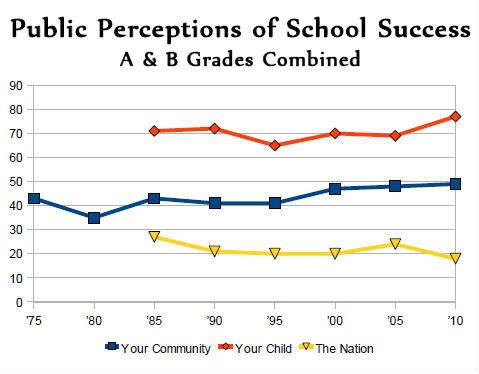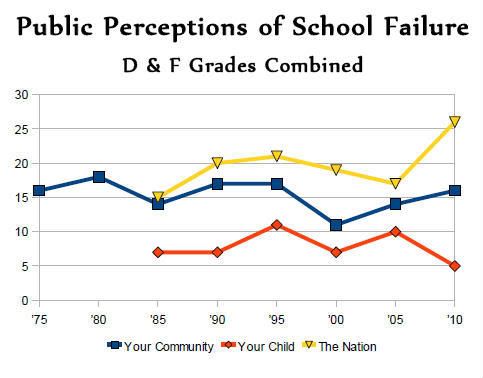Wisconsin’s Democracy Explosion Partially Due to Sharply Split Views of School Success–Local vs. National
Cross-posted from Merge Left
One reason that Wisconsin erupted the way that it did is a long-standing disconnect between the power of the national discourse about failing schools–which people tend to buy into in the abstract–and the reality of the fact that most people feel that the schools their children go to are doing a pretty good job. So long as the education discourse remains national, abstract, and removed from most people’s experience, it has proven relatively easy to keep moving that discourse into a gloomier and gloomie direction, a process that has grown more intense than ever the past half decade or so. But when the battleground suddenly shifted to putting local teachers under the gun, Republicans gravely miscalculated where the public’s sentiments would lie. Several decades of data tell us that we shouldn’t have been surprised.
In a diary at DKos Sunday, Teachers: the new enemy of the states?, Steve Singiser wrote:
The boldness with which the foes of teachers unions are surging forward seems to hint at the fact that they feel at, in this moment, they have the upper hand with the electorate. And they may well be right.
Consider an odd disconnect in a Gallup survey on education conducted late last summer:
Percent declaring they are satisfied with the quality of K-12 education in the United States (2004 results in parentheses)
Satisfied: 43 (53)
Dissatisfied: 54 (45)Percent declaring they are satisfied with the quality of their own child’s education (2004 results in parentheses)
Satisfied: 80 (79)
Dissatisfied: 19 (19)What these results would seem to imply is that there has been some negative movement on the perceptions of K-12 education (admittedly, 2004 was a high-water mark, but it’s worth noting that 2010 marked the lowest support on this question since 2001).
But the data also implies that parental observations of their own child’s education have not diminished at all. Indeed, the 80% satisfaction level recorded in the 2010 survey was the strongest level of satisfaction since 1999.
In fact, the disconnect between views of education at the national level and those parents have of their own children’s schools have always been substantial, ever since Gallup began asking the questions in their joint polling series in association with Phi Delta Kappa. (PDK’s poll results announcement here, PDF here) There has been a noticeable spike in the negative nationwide perceptions over the past half decade, but it’s building on a long-standing historical foundation that is grounded more in propaganda than in reality.
Needless to say, parents have a much better chance of knowing what schools are like when they have first- and/or second-hand experience, as they do with the schools their children attend. This doesn’t guarantee the accuracy of their perceptions, of course. But it does give them a better shot. When it comes to the nation at large, however, they are almost entirely at the mercy of the media, and the media bias against America’s public schools has been pretty relentless at least since the publication of “A Nation At Risk” in 1983. The right’s anti-public education push–aided and abetted by neoliberals, of course–has been relatvely successful so long as its been waged in the national media, with mostly uncritical trickle-down to local coverage. But what happened in Wisconsin is an indication of what this polling history would lead you to expect: If you shift the battleground from the national media to the local schools, the odds shift dramatically in favor of public education. That’s exactly what’s happened, and it really shouldn’t come as any surprise.
Let’s look at the long-term data in three different ways: perceptions of school success, school failure, and the ratio of the two. Gallup uses a letter-grade scale, so we rate A’s and B’s as “success”, D’s and F’s as failure. First we’ll look at success, then success/failure ratios and then failure.
Perceptions of School Success
Over the past 25 years, parents have generally given high marks to the schools their children go to–between 70 and 80% A’s and B’s for most years. This is in sharp contrast to their views of schools in the nation at large, which are rated just the opposite–between 70 and 80% NOT A’s or B’s–with a sharp downward turn past 5 years. The views of local schools have fallen roughly half-way in between.

If we compare the views parents have of their own child’s school to those of schools in the community or the nation at large, this is how views of school success have changed over the years. As can be seen, the perception of schools in the community has remained fairly constant as a ration–parents have consistently given their own children’s schools A’s and B’s about 50% more frequently than they give similar scores to schools in the communities they live in. But the view of the nation’s schools has been both more volatile and more negative, with a sharp jump in negative views the last 5 years. Parents now give their own children’s schools A’s and B’s more than 4 times more frequently than they give those grades to the nation’s schools. Clearly, the overwhelming majority of Americans think their own children’s schools are well above average:

Perceptions of School Success vs. Failure
These results are only intensified if we look at a measure of success vs. failure: the ratio of A’s and B’s to D’s and F’s. Not only is the gap between parents’ perceptions of their own children’s schools and other schools more pronounced, the improvement in their perception of their own children’s schools has literally skyrocketed the last five years at the same time it has dipped for both schools in their community and in the nation at large:

The positive view of their own children’s schools is so strong, that in order to see their opinion of other schools, I’ve redone the above chart with their own children’s schools removed and the scale expanded:

Again, we turn to our ratio comparisons. Looking at the ratios of perceived success vs. failure in other schools compared to their own children’s schools, we see relatively modest fluctuations in the views of community schools, significantly larger fluctuations in the views of the nation’s schools as a whole, and a truly mammoth spike since 2005, during which time the success vs. failure perception for the their own children’s schools skyrocketed from five times better than the nation as a whole to about 22 1/2 times better–a jump of 4 1/2 times:

Perceptions of School Failure
Only a small fraction of parents–varying between 5% and 10%–have regarded their own children’s schools as failing, while they see schools in their communities failing at a higher rate, fluctuating around 15% since 1975. The perceived national failure rate started off about equal to the perceived community failure rate in 1985, but has generally trended upward since then, with a dip in 2005 followed by a sharp rise through 2010, another indication of the growing power of anti-school propaganda, even as parent’s perceptions of their own childrens’ schools moved lower than previous low levels:

The combined impact of decreased perceived failure rates in parents’ childrens’ schools and increased perceived failure rates in schools nationally and in the community over the past five years has created a sharp upticks in the ratios–an indication of a divergence in perceived failure rates, which has made the national mood of perceived trouble in education an even more unreliable predictor of how people feel about their own local school than ever before:

What’s Wrong With This Picture?
These perceived failure rates–even the worst of them–stand increasingly at odds with what the dysfunctional “national concensus” is telling us. An AP story Tuesday,
“Are 82 Percent Of U.S. Schools Really ‘Failing’?” revolved around the prospect that:
The Department of Education says the number of schools that fail to meet the annual proficiency goals could jump from 37 to 82 percent this year. That would include schools that have not met the requirements for just one year.
The possibility–or impossility–of that dramatic jump was the focal point of the story, which also took pains to say:
There is no “failing” label in the No Child Left Behind Act. And schools that do not meet growth targets – aimed at getting 100 percent of students proficient in math, reading and science by 2014 – for one year are not subject to any intervention.
Still, the failure to meet NCLB goals clearly is some sort of failure in the NCLB framework. And the number of schools currently “failing” by that measure is 37%–a good ten points more than the polling figure for the nation’s schools, which is at an all-time high. Some critics long have claimed that NCLB was a de facto attempt to undermine public education by establishing a framework of goals that would eventually label virtually of the naiton’s schools as failures, simply because of how it was structured.
If the deeper lessons of Wisconsin are learned, it seems virtually inevitable that the Washington consensus on education will itself finally get the failing grade it so richly deserves. Schools need help–yes. They do not need rule by distant bureaucrats preparing the way for privatization.

Paul Rosenberg
Paul Rosenberg is not a dirty hippy. He bathes once a month, whether he needs it or not. An erstwhile programmer, he was a freelance op-ed and book review writer from 1994/96 to 2002, and has been a staff writer & editor at Random Lengths News, an alternative bi-weekly in the Los Angeles harbor area from 2002 to date. His October 2002 story “Iraq Attack-The Aims and Origins of Bush’s Plans” shared the Project Censored #1 Censored Story award for 2004.
10 Responses to Wisconsin’s Democracy Explosion Partially Due to Sharply Split Views of School Success–Local vs. National
Recent Comments
- Kucuka.net on Intellectual Property is a bad thing.
- evgeniy levchenko datums aangemeld on Debt slavery is a natural consequence of unregulated capitalism
- best career counselor on What will it take to address the climate emergency
- hyip on Debt slavery is a natural consequence of unregulated capitalism
- Tony Williams on Debt slavery is a natural consequence of unregulated capitalism
Blogroll
- 4dancers
- Aaron Krager
- Amygdala
- Autonomy for All
- Away Point
- Blue Jersey
- Bluemars
- Brad Blog
- Campaign for America's Future
- Cassandra Files
- Clear It with Sidney
- Cogitamus
- Crooks and Liars
- Cucking Stool
- Daily Show with Jon Stewart
- Dirty Hippie Sports Talk
- Disaffected and It Feels So Good
- Dispatches from the Culture Wars
- Dork with a Nerd Rising
- Eastern Sunz
- Florida Progressive Coalition
- Focal Points
- FOK News Channel
- Frederick Clarkson
- Frustrated Teacher
- Greatscat!
- HandPicked Nation
- Jazz from Hell
- jazz89 KUVO Public Radio
- Kenneth J. Bernstein
- La Bloga
- Lee Camp
- Litbrit
- Live Free or Die Alliance
- Live from the Left Coast
- MarioWire
- Media Matters
- Merge Left
- Mind Potion Radio
- MPA Political
- New York Communities for Change
- Nuclear Diner
- Political Carnival
- Progressive Leadership Action Network
- Progressive PST
- Radio or Not
- Republic Report
- Scholar as Citizen
- Scholars and Rogues
- Seeing the Forest
- Smirking Chimp
- Smoking Politics
- SomaFM
- Somos Tejanos
- Speak Out California
- Spedwybabs
- Spocko's Brain
- Stark Reports
- StarTalk
- Suburban Guerilla
- Symphony of Science
- Talk to Action
- thereisnospoon
- Today's Workplace
- Truth Vigilante
- Waking from the American Dream
- Worldwide Hippies
- WTF Is It Now?!?
- Error: Could not open handle for fopen() to http://heyhippies.tumblr.com/api/read?num=2
Category Cloud
Activism Americans Barack Obama Blogging Budget Bush II Administration Business Capitalism Class Warfare Congress Conservatives Corporatism Corruption Democracy Democrats Dirty Hippies Economy Education Elections Extremism Government Greed Health Care Jobs Journalism labor Media messaging Obama Administration Politics Progressives Religious Right Reproductive Rights Republicans Satire Social Security Taxation Tea Party Uncategorized Unions US Politics Violence Wall Street Wealth Wisconsin


It seems to me that your interpretation could have been a lot stronger.
1. Many of the people who believe that the schools are failing don’t know what they’re talking about.
2. A strong majority of parents like the school that they know best, but believe media rumors about the schools in the nation as a whole.
3. Many of those most negative about public schools have no personal investment in the system at all, and are working on other agendas: lowering taxes, busting unions, fighting against secularism, bashing liberal teachers.
Diane Ravitch, a former school basher, wouldn’t go as far as I have but she’s extremely disillusioned with the “school reform” movement of which she used to be an integral part (one of the few actually involved in education, IIRC).
Maybe my language wasn’t as strong, but that’s pretty much what I was saying, plus one thing more: Wisconsin is evidence of what happens when they try to push things too far.
It would be preferable if we had at least one major political party that would make the case for public education, and activate what people know from their own experience while downplaying the corporate rhetoric.
The sad thing is that in places without much in the way of a Republican Party, like DC, Democrats are no better than they are elsewhere (if not worse).
My hope is that Wisconsin will be a turning point for us.
As this fight spreads across multiple states, the neoliberal education faction is going to be increasingly irrelevant at best.
Paul Rosenberg, I am very happy to have found your writing again.
I guess I also mean “you’re.”
More is hidden than is revealed.
Thanks for the great post. What I’d like to know is are there any valid evaluations of how schools across the US are really doing?
Not really, that I’m aware of. There’s the NAEP, which seems to be a valid measure of student performance on a set of fundamental measures. But it doesn’t really reflect the contribution of schools as distinct from the basic driving factors of family and community affluence.
Sigh.